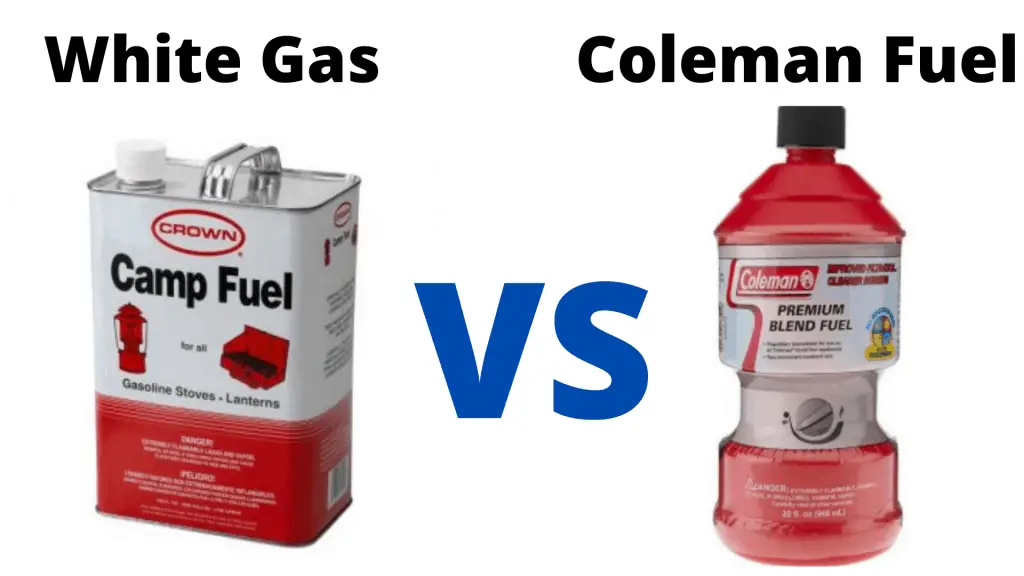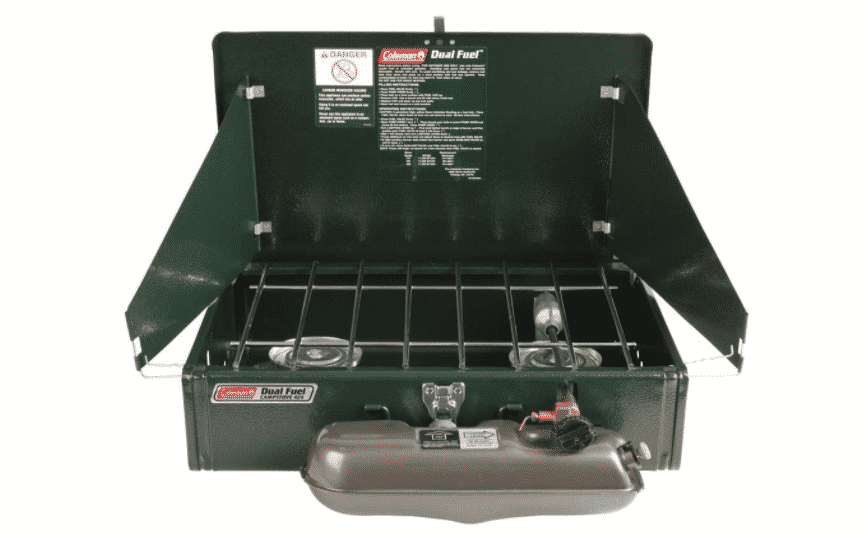There are lots of different types of fuels for camping stoves. I’ve owned a liquid fuel camping stove for as long as I can remember. Nobody ever bothered to tell me, what’s the difference between Coleman Fuel and White Gas?
So, Coleman Fuel vs White Gas, what’s the difference? There isn’t much of a difference between Coleman Fuel and White Gas. White gas is usually just the generic name for name-brand Coleman Fuel. They can be used interchangeably even though Coleman fuel adds additional stabilizers and anti-corrosive additives.
Do you really need to spend the extra money on Coleman fuel or can you use regular old generic white gas? Continue reading below if you’re trying to decide between Coleman fuel and white gas. Don’t worry, there really is no wrong choice!
What’s The Difference Between White Gas and Coleman Fuel?

There Really isn’t much of a difference between Coleman Fuel and White Gas. They burn almost exactly the same and they can be used interchangeably. With that being said, there are a few subtle differences.
Whether or not Coleman Fuel and white gas are the same depends on where you live. Overseas these two products are exactly the same. Fuel is highly regulated throughout most of Europe.
However, in the United States there is a slight difference. Coleman Fuel that’s made in the United States has additional stabilizers and anti-corrosive additives.
These products both increase the shelf life of your fuel and reduce the damage on your camping stove. Only you can decide if the added cost of Coleman Fuel is worth it.
Coleman Fuel vs White Gas
- Coleman Fuel Lasts Longer: White gas actually has a really long shelf life. An unopened container of white gas can last between 5-10 years. Problems start to arise after the container is exposed to air. The shelf life drops to about 1 year, which is where Coleman’s fuel stabilizers come in. The difference is hard to tell, but it should add about 6 months to 1 year to an opened bottle of fuel.
- Coleman Fuel is Anti-Corrosive: White gas and Coleman fuel are both safe to use in a camping stoves and lanterns. Neither product will cause extensive damage to your camping gear. The anti-corrosion additives don’t make much of a difference to most people. It really only matters if you plan on leaving fuel in your stove for extended periods of time(this isn’t recommended).
Over in the European market Coleman Fuel and white gas are the same product. The only difference is the label and price. It has the same chemical formula and it’s sold in the exact same bottles. So just buy whatever is cheap and easy to find.
On the other hand, USA made Coleman fuel removes the dirty additives found in regular gasoline while adding stabilizers and anti-corrosive agents. So you get a fuel that’s stable long term without gunking up your fuel lines.
Plus thanks to the anti-corrosion properties Coleman Fuel won’t cause long term damage to the burner and internal components. Your fuel will stay stable longer without damaging your gear. Whether or not this makes a difference depends on how long it takes to go through your fuel.
Here’s more info on storing white gas and Coleman fuel safely. You might also want to check out my post explaining how long white gas lasts and when you need to throw it away.
Is Coleman Fuel better than white gas, or is it a Ripoff?
Why buy Coleman fuel when white gas is basically the same thing? A lot of people think that it’s a ripoff compared to traditional white gas. Should you save your money and just purchase generic white gas?
Priced at about $12+ per gallon locally it definitely isn’t cheap. You don’t even need to go to a camping store. It can be found in the sporting good section at most Walmarts.
You can even buy Coleman Fuel on Amazon if you’re willing to buy smaller 32 oz bottles and pay a slight premium. The small bottles are actually really nice for weekend camping trips. It’s just less weight to carry into camp.
There’s actually a reason why Coleman Fuel is so darn expensive. It all boils down to economies of scale. It’s hard to get production costs down with such a small market compared to gasoline and white gas. Only you can decide if the added shelf life and anti-corrosion is worth it.
FAQ About White Gas and Coleman Fuel
Coleman fuel is pretty much the same thing as white gas. There are stabilizers and anti-corrosion additives in Coleman Fuel made in the United States. However most people won’t be able to tell the difference. Just buy whatever is easiest to find locally.
You should only use Coleman Fuel or White gas in a Liquid Fuel Coleman Stove. They burn clean and won’t cause long term damage to the internal components of the stove.
Unfortunately, white gas and coleman fuel isn’t easily available in some foreign countries. Your next best choice is kerosine or diesel. Both of these fuels are easy to find, but they’re dirty and diesel has a strong odor. Gasoline should only be used as a last resort.
No white gas is not the same as gasoline. White gas aka Naptha is way more pure than gasoline. White gas burns way cleaner and burns at a lower temperature. So your stove will be easier to start , cleaner, and run way better than if you used gasoline.
Gasoline will also damage the internal components of your stove. The additives used to make cars run smoothly will eat away at your stoves pump and fuel line. It will work in a pinch if you buy low-grade gasoline with fewer additives.
To add more complexity to the equation additives and mixtures change regularly depending on the region and time of year. Gas might be fine to use in Texas, but terrible in Colorado during the winter. It’s really hard to say what you’re putting in the stove.
I wouldn’t recommend using gasoline in your camping stove. With that being said I have used it dozens of times over the years without problems. Kerosene is way better to use if you can find it.
If you go on enough camping trips you will eventually forget to pack your fuel or run out early. Don’t run around searching for white gas when you can get gasoline locally.
You can always clean or replace your fuel lines when you get home. Would I use white gas instead of gasoline just because it’s cheaper? No, it’s not worth the added hassle, but it’s convenient to use in a bind.
Storing white gas is easy. Just keep it in an approved container and place it into a cabinet away from heat sources. Avoid using glass and plastic containers. Check out my post explaining how to store white gas for more info.
White gas lasts a really long time compared to traditional gasoline. I’ve used old containers that my dad bought when I was a child. They might not burn perfectly, but it works in a bind.
You can expect to get at least 5-10 years(maybe more) out of an unopened bottle of white gas. In colder temperatures you’ll want to use the white gas by the 5 year mark.
The shelf life drops to about 1 year after opening the bottle. Air causes fast degradation of fuel. Here’s more info on the shelf life of white gas and how to use old fuel.




